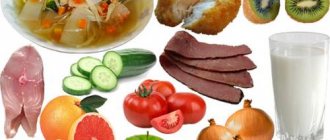In this article we will tell you:
- Causes of obesity
- Adipose tissue as an endocrine organ
- Obesity disorders
- Fatty liver
- Nutrition for obesity
- Prohibited Products
- Childhood obesity
- Nutrition Strategies for Children
- Diagnosis of obesity
- Pregnancy and obesity
Obesity
- one of the most common pathologies of the 21st century and a real scourge of modern society. This is a widespread problem in all countries - from highly developed ones (for example, in the UK, the percentage of overweight patients has long exceeded 20) to less industrialized ones. According to WHO estimates, in 2004 alone the number of obese people exceeded 1.4 billion - what can we say now, 12 years later?
This is not only a decisive factor and trigger for most cardiovascular diseases and metabolic disorders, but also a disease that significantly reduces the standard of living.
Causes of obesity
Genetics, of course, plays a significant role at all levels of the functioning of the body and makes a significant contribution, in particular, to the constitutional features of the structure. However, the final word remains with external factors and the conditions that surrounded the child from the cradle: after all, even the healthiest baby, with the wrong approach from parents, threatens not only to gain extra pounds and centimeters of subcutaneous folds, but also to develop persistent eating habits that are similar to those of an adult. age will invariably become an obstacle to the right lifestyle.
Among the main causes of excess weight are the following:
- Energy imbalance
- in other words, we consume more than we can spend.
Our body is an ingenious system, which in any situation - in the conditions of peaceful coexistence of all residents inhabiting it, both cellular and non-cellular in structure, or during civil wars in the form of autoimmune diseases, when foreign pathogenic agents invade its territory - takes care mainly about one goal: how to maintain balance - the key to normal functioning, first of all, of enzymes.
Most reactions occurring in the human body require energy. Glucose transport, ion transport, activation of signaling pathways - all require a kind of currency in the form of ATP molecules. So, it is simply unprofitable to eliminate all the excess substances that come with food through the intestines: you never know when that rainy day will come.
Thus, adipose tissue, at one time, ensured survival: our ancestors did not manage to kill mammoths and saber-toothed tigers every day.
- Hypothalamic disorder
- the main conductor of energy exchange. It is in this, one of the key structures of the brain, that the centers of “hunger” and “saturation” are located, and a number of protein and polypeptide molecules involved in the control of appetite are produced.
- Endocrine
- decreased thyroid function (hypothyroidism), decreased production of adrenal hormones and somatotropin by the adenohypophysis.
- Sleep disorders
: the synthesis of hormones responsible for hunger and satiety (ghrelin and leptin) is associated with the sleep-wake cycle.
- Long-term use of certain medications
- in particular, glucocorticoids.
Adipose tissue as an endocrine organ
Adipose tissue
- a source of many biologically active substances and hormones that exhibit both central and peripheral effects.
First of all, leptin is produced here - a satiety hormone, which, freely passing through the customs border of the blood-brain barrier (using a special transport system) separating nervous tissue from the circulating blood, affects the receptors of the hypothalamus - a key structure of the brain, where it reduces the production of the hormone responsible for hunger neuropeptide Y. A feeling of satiety occurs.
Interestingly, the level of this hormone differs significantly between men and women - in the former it is significantly lower, which is associated with higher concentrations of testosterone in the blood.
An increase in the amount of adipose tissue is invariably accompanied by an increase in leptin production, which entails a natural decrease in the sensitivity of cellular receptors to it - leptin resistance develops.
Study
: Obesity
Such disorders affect not only appetite dysregulation: leptin is also involved in the functioning of the reproductive system. Thus, many researchers note the cyclical nature of leptin levels, which is associated with the sequential change of conductors in a woman’s body—sex hormones. In particular, its concentration reached a maximum in the luteal phase, when this protein hormone actively stimulated the programmed death of corpus luteum cells - their apoptosis - in the absence of pregnancy.
Study
: The hormone leptin and reproduction problems
Another equally important hormone produced by fat cells is adiponectin
- also has, like leptin, a protein nature. Activation of signaling pathways leads to:
- Increased glucose utilization by skeletal muscles.
- Relaxation of smooth muscles and, as a result, a decrease in blood pressure. This effect is mediated by stimulation of endothelial cells, the inner lining of blood vessels, to produce a relaxation factor - nitric oxide.
- Prevents the division and calcification of smooth myocytes of the vascular wall, thus providing an antiatherogenic effect. In addition, it suppresses the uptake of cholesterol and its esters by cleansing cells - macrophages - which, despite the wide range of enzymes they contain, are unable to break down this organic compound and only accumulate it, turning over time into so-called “foam” cells .
- Suppression of glucose synthesis from non-carbohydrate components - inhibition of gluconeogenesis in the liver.
Study
: Metabolic effects of adiponectin
Obesity disorders
- Hypertonic disease
- is associated, first of all, with the direct stimulation of the sympathetic nervous system by insulin, the concentration of which in the blood is many times higher than normal in people with excess body weight (its mediators, as is known, interact with the corresponding receptors on myocardial cells, increase the frequency and strength of contractions, and also have a direct effect on smooth myocytes of the vascular wall).
In addition, insulin also affects the kidneys: it promotes the retention of sodium, which drags water along with it - the volume of circulating blood increases.
With obesity, the production of angiotensinogen by adipocytes also increases - its subsequent conversion to angiotensin 2 stimulates the adrenal cortex to secrete aldosterone, a mineralocorticoid, which causes reabsorption of sodium in the renal tubules and the secretion of potassium.
In addition to this, the right atrium reduces the synthesis and release of natriuretic hormone, which helps reduce the concentration of sodium in the blood by excreting it in the urine - edema develops.
Study
: Obesity‐Related Hypertension: Pathogenesis, Cardiovascular Risk, and Treatment
- When fat is deposited in the chest and abdominal area, the mobility of the diaphragm - the main respiratory muscle - and ribs is limited, which leads to violations of ventilation of the pulmonary parenchyma
. In such patients, there is a decrease in vital capacity of the lungs, as well as a decrease in forced expiratory volume.
In addition, obesity suppresses the synthesis of the pro-inflammatory hormone adiponectin, which increases the risk of bronchial asthma.
- Disorders of carbohydrate metabolism
- in particular, the development of insulin resistance - a decisive step in the pathogenesis of type 2 diabetes mellitus. So, say, in the liver, free fatty acids prevent insulin from binding to hepatocytes, and also suppress the inhibitory effect of this hormone on gluconeogenesis (the synthesis of glucose from non-carbohydrate components).
In addition, free fatty acids have a toxic effect on the insulin-producing beta cells of the pancreas and impair the uptake and further utilization of glucose by skeletal muscle.
Study
: Obesity and insulin resistance
Diet for obesity 4 degrees
Patients who are 100% overweight usually require constant care. They have difficulty moving, cannot climb stairs, wash themselves in the bathroom or travel on public transport. Every step is difficult for them. Such patients have a whole bunch of serious diseases associated with excessive body weight: atherosclerosis, hypertension, diabetes mellitus, pancreatitis, Pickwickian syndrome - respiratory failure.
Obesity at stage 4 requires a comprehensive approach: a special diet and, quite possibly, surgical intervention. Treatment in a hospital, under the supervision of a doctor, is advisable.
Read more: Effective tips for losing weight
Fatty liver
Non-alcoholic fatty liver disease
(NAFLD) is one of the most common diseases in gastroenterology, which is characterized by the overgrowth, in the literal sense of the word, of hepatocytes with fat cells - the liver turns into goose foie gras.
Fatty liver, as a rule, is associated with excess intake of carbohydrates into the body: when all the energy needs of the cells are satisfied, part of the excess will be wisely stored in the liver storerooms in the form of glycogen - an energy reserve for a “rainy day”. However, given the limited space allocated for storing jars of jam, what could not be transformed into glycogen will turn into lipids in the process of biochemical reactions.
So, you shouldn’t be afraid of fats in your diet: they gain weight precisely because of the uncontrolled intake of sugars, which initially seem healthy and harmless. “Everything is poison and everything is medicine,” Paracelsus correctly stated.
We recommend
“What is vitamin D for: a detailed review” Read more
Obesity activates a signaling pathway in hepatocytes that is invariably associated with chronic inflammation and increased levels of lipid metabolites such as diacylglycerol. The latter, by preventing phosphorylation of the insulin receptor, directly contributes to the development of insulin resistance.
In addition, an increase in the concentration of free fatty acids contributes to the disruption of their oxidation in our power plants - mitochondria - and leads to an increase in the production of free radicals located in them. Oxidative stress develops, which further damages the organ parenchyma and stimulates the progression of fibrosis - the replacement of liver cells with connective tissue.
In most patients, NAFLD does not manifest clinical symptoms, or they are not specific enough:
- dull pain in the right hypochondrium;
- fatigue;
- dyspepsia;
- hepatosplenomegaly - an increase in the size of the liver and spleen.
Laboratory indicators also do not always reflect the picture: for example, the levels of ALT and AST (alanine aminotransferase and aspartate aminotransferase) may be slightly elevated or even remain within normal limits - which is why it is undesirable to rely solely on their concentration when making a diagnosis.
It is much more effective to assess uric acid (more than 20% of overweight individuals have hyperuricemia), C-reactive protein, and serum ferritin concentrations, both of which are characteristic and highly sensitive markers of inflammation and are elevated in fatty liver disease. In addition, insulin, glucose and C-peptide levels, as well as the lipid profile, must be monitored.
Study
: Non-alcoholic fatty liver disease and obesity: Biochemical, metabolic and clinical presentations
Product Lists
The diet for obesity, given the seriousness of the disease and the danger of consequences, is strict. Therefore, the lists of permitted and prohibited products are clearly regulated.
Allowed:
- buckwheat, pearl barley, barley porridge;
- green vegetables enriched with fiber: cucumbers, zucchini, cabbage;
- honey;
- low-fat dairy products;
- drinks: black, herbal, green tea, rosehip infusion, chicory, coffee with milk;
- lean meat and fish;
- 1 egg per day: hard-boiled or scrambled;
- mild and low-fat sauces: tomato, white;
- flaxseed, sunflower, olive oil (15 ml per day);
- butter (5 grams per day);
- fresh berries and fruits - not very sweet;
- soups: vegetable, fish, with cereals, meatballs, beetroot soup, cabbage soup, borscht;
- bread: rye, wheat, whole grain, coarsely ground;
- berry and fruit compotes, jellies, mousses.
Prohibited:
- alcoholic drinks;
- grapes, raisins, dates, bananas, figs;
- baked goods from yeast, puff pastry, shortbread dough;
- animal fats;
- fatty meat and fish;
- canned food;
- pasta, semolina, white rice, beans;
- dairy products with a high percentage of fat content;
- spicy and fatty sauces: mayonnaise, mustard, horseradish;
- packaged juice, jelly, kvass, cocoa;
- sweet confectionery, ice cream, candies, chocolate;
- pickles and marinades;
- offal;
- fast food;
- bread: white, made from premium flour, buns.
If you are overweight, these two lists will become your guides for a long time in organizing proper nutrition and creating a diet menu. Depending on the severity of the disease and individual characteristics, the doctor may adjust the diet, so be sure to follow his recommendations.
Nutrition for obesity
Obese patients, in addition to moderate physical activity, need to create the right diet in tandem with a nutritionist that satisfies all the necessary needs of the body. First of all, the main rule for them can be formulated as follows: spend more than you receive.
Strict calorie restriction is a direct road to breakdown and subsequent depressive states and self-flagellation. Yes, reducing your calorie intake makes sense - but only in cases where it is adequate and gradual.
In general, in the absence of adrenal fatigue, three meals a day remains a universal diet for most people. Maintaining “hungry” intervals by eliminating all snacks between main meals helps to establish carbohydrate metabolism and increase the sensitivity of cell receptors to insulin.
In addition, it is advisable to adhere to intermittent fasting - its simplest variation, which you need to start with, is 12/12 - in other words, within 12 hours you eat (2 or 3 meals are ideal), in the remaining 12 ( including sleep) - drink exclusively water, herbal teas or coffee without milk or sugar.
Over time, you can “lengthen” the fasting window and move on, for example, to practicing 14/10, 16/8 and 20/4 - any of these techniques is an effective way to carefully, smoothly lose weight, and then maintain its normal level.
Also, patients with excess body weight should exclude fast carbohydrates - sweets, dried fruits, honey, which contribute to a rapid increase in glucose levels and an equally sharp decline. Considering that in the mechanisms of development of insulin resistance, one of the key roles belongs to fructose, which sophisticatedly bypasses all saturation pathways, strict control over fruit consumption and their limitation are mandatory.
It is recommended to consume at least 30 grams of fiber - this is not only a powerful stimulator of intestinal motility, but also a kind of broom that cleanses its lumen. You can use psyllium powder or apple pectin as a source, washing them down with water or adding them (as a binder) to the dough. However, given that dietary fiber also acts as a sorbent, it must be taken separately from other dietary supplements.
Diet for obesity 1st degree
A person at this stage does not yet consider extra pounds a disease; he usually does not have any complaints. For this category of people, the norm is high physical and mental stress. Only a part of them may complain of general weakness and increased fatigue.
If you do not start getting rid of excess fat deposits during this period, then in the future this can lead to the development of diabetes mellitus and hyperinsulinemia, ovarian hypofunction (in women), and menstrual irregularities. To avoid such complications, active movement during the day and a balanced diet are recommended. It should consist of 60% proteins (including those of animal origin), 25% vegetable fats, 5-8 g of salt and up to 1.2 liters of liquid daily.
Sugar is completely excluded, except that you can use its substitutes. All dishes are prepared without salt; they are added separately. You should eat food at least 6 times a day, little by little.
Approximate diet for one day:
1st breakfast
: low-fat cottage cheese (100 g), stewed carrots (200 g), coffee with milk without sugar (200 g).
2nd breakfast
: apple or fresh cabbage salad without salt with a spoon of sour cream (170 g).
Dinner:
vegetable borscht (200 g), stewed cabbage (150 g), boiled meat (90 g), dried fruit compote without sugar (200 g).
Afternoon snack
: low-fat cottage cheese (100 g), rosehip decoction (200 g).
Dinner
: boiled fish, for example, pike perch (100 g), vegetable stew (125 g), green tea (200 g).
For the night:
low-fat kefir (150 g).
The permissible amount of bread for the whole day is 150 g.
Read more: Diets that allow you to lose weight by 5 kg
Prohibited Products
If you are overweight, it is strictly necessary to limit your intake.
:
- candies, ice cream, marshmallows, marmalade and other sources of refined sugars;
- sweet fruits
: mango, banana, persimmon;
- freshly squeezed juices and smoothies
- this is a real sugar bomb under the guise of a healthy lifestyle product;
- ready-made sauces
: they are not only sources of glutamates that excite the nervous system, but also extra calories and hidden sugar;
- fast food and semi-finished products;
- bakery products, instant cereals;
- dairy products
: they increase plasma levels of insulin and insulin-like factor-1, and also help increase the production of androgens;
- carbonated and alcoholic drinks.
Childhood obesity
Childhood obesity
- one of the most pressing problems of the modern world - is the result of long-term energy imbalance, when the amount of energy consumed many times exceeds the body's needs.
Despite the certain role of genetics, the increase in the number of children suffering from obesity is associated primarily with low levels of physical activity and the predominance of junk food rich in sugars and trans fats in the diet.
Neuroendocrine disorders, congenital anomalies and chromosomal mutations fade into the background - their role in gaining excess body weight against the background of the influence of environmental factors is becoming more and more insignificant.
So, in the UK only in 2008, according to statistics, 16.8% of boys and 15.2% of girls aged 2 to 15 years had problems with excess body weight - one can imagine how these figures have changed now, 12 years later.
Obesity is associated with the development of insulin resistance, impaired glucose tolerance, and increased blood pressure, all of which contribute directly or indirectly to the development of chronic diseases. Similar to the adult body, in the child’s body the following are also noted:
- sleep apnea;
- cardiovascular pathologies;
- osteoarthritis;
- hypertension;
- depression, low self-esteem and deterioration in quality of life.
Study
: Obesity in children
Nutrition Strategies for Children
| Age | Calories | Fluid intake |
| 1 year | 900 kcal/day | 1100-1200 ml/day |
| 2-3 years | 1000 kcal/day | 1300 ml/day |
| 4-8 years | 1200 kcal/day for girls 1400 kcal/day for boys | 1600 ml/day |
| 9-13 years | 1600 kcal/day for girls 1800 kcal/day for boys | 1900 ml/day for girls 2100 ml/day for boys |
| 14-18 years old | 1800 kcal/day for girls 2200 kcal/day for boys | 2000 ml/day for girls; 2600 ml/day for boys |
| Age | Number of fruits | Number of vegetables |
| 1 year | 1 cup per day (250 ml) | ¾ cup per day |
| 2-3 years | 1 cup | 1 cup |
| 4-8 years | 1.5 cups | 1 cup for girls; 1.5 cups for boys; |
| 9-13 years | 1.5 cups | 2 cups for girls; 2.5 cups for boys; |
| 14-18 years old | 1.5 cups for girls; 2 cups for boys; | 2.5 cups for girls; 3 cups for boys; |
Fasting days for stage 2 obesity
In this case, it means including only one product in the daily diet, for example: meat, kefir, apples, watermelon, buckwheat.
To make unloading for the body as beneficial as possible, you should listen to some tips:
- During the week, two fasting days are enough;
- Before going to bed, you can eat a little prunes or dried apricots for normal bowel function;
- It is advisable to avoid stressful experiences.
Mono-diet options:
- Apple. In 5-6 meals you need to eat 1.5 kg of fruit. Method of preparation: chopping with a grater or baking with cinnamon in the oven.
- Cucumber. You also need to eat 1.5 kg of vegetables, and during lunch and dinner you can eat a cucumber along with a soft-boiled egg.
- Meat. The amount per day is 280-350 g of boiled product, which is supplemented with a vegetable side dish.
- Cottage cheese. The daily volume of cottage cheese is 500-600 g. It can be washed down with coffee or tea without added sugar (2-3 cups).
For best results, unloading should be combined with moderate training. It is important to monitor weight loss.
Diagnosis of obesity
Obesity
- one of the main components that make up metabolic syndrome. This is a whole complex of pathologies, which includes:
- insulin resistance;
- diabetes mellitus type 2;
- arterial hypertension;
- tendency to thrombosis;
- dyslipidemia;
- visceral obesity.
We recommend
“Microelements in the body: consumption standards and methods of replenishing the deficiency” Read more
According to WHO criteria for 2002, the following laboratory parameters are taken into account when making a diagnosis:
| BMI | over 30 |
| Fasting plasma glucose | more than 6.1 mmol/l |
| Triglyceride levels | more than 1.7 mmol/l |
| HDL content | for men - less than 0.9 mmol/l; for women - less than 1 mmol/l. |
| Waist-hip ratio (visceral obesity indicator) | For men > 0.9 For women > 0.85 |
| Arterial pressure | ≥140/90 mmHg |
Study
: Diagnostic criteria for metabolic syndrome
Pregnancy and obesity
Pregnancy
- a unique period in the life of every woman, which is characterized by a number of quantitative and qualitative changes aimed at creating the most favorable conditions for the growth and development of a new organism.
There is an intensive development of fatty tissue - that metabolic safety cushion that will provide the fetus with the necessary substrates for energy. We have already talked about the hormonal function of this tissue: here, due to the fairly high activity of the aromatase enzyme, androgens are transformed into estrogens - primarily into estradiol, thus mediating the extraovarian synthesis of sex hormones.
However, excess body weight is accompanied not only by a more enhanced function of the previously mentioned enzyme: changes also occur in the composition of estrogens themselves - in particular, the number of their active forms exceeds inactive ones. To this should be added the direct production of estrogen by the placenta - thus, the arithmetic summation reflects the development of hyperestrogenemia.
During the gestation period, the production of progesterone, a direct competitor of glucocorticoids for receptors in fat cells, also increases; by binding to them, it makes it impossible for adrenal hormones to activate lipolysis, the process of burning fat.
Starting from the 6th week, placental trophoblasts actively synthesize leptin, which stimulates hematopoiesis in the fetus and is involved in the regulation of growth and development processes. So, pregnancy is characterized by a whole orchestra of hormonal changes, however, a positive energy balance still plays a decisive role in the mechanisms of obesity.
There are specific recommendations regarding weight gain during pregnancy developed by the Institute of Medicine of the American Academy of Sciences and based on baseline body mass index. We remind you that BMI = weight (kg) : height² (m²)
| BMI before pregnancy | Body weight gain throughout pregnancy (kg) | Body weight gain per week (kg) |
| Low body weight (BMI < 20) | 12.5-18 | 0.5 |
| Normal body weight (BMI = 20-25) | 11.5-16 | 0.4 |
| Excess body weight (BMI= 25-30) | 7-11.5 | 0.3 |
| Obesity (BMI > 30) | < 7 | 0.2 |
Complications associated with excess weight
, during gestation are observed in 85% of patients and are accompanied by:
- Cardiovascular pathologies.
- Disorders of carbohydrate metabolism - physiological insulin resistance normally develops, in which the sensitivity of peripheral tissues to this pancreatic protein hormone is slightly reduced, which is necessary, first of all, to provide the developing fetus with energy.
Visceral obesity, in itself, is accompanied by excessive concentrations of insulin in the blood. Hyperinsulinemia occurs due to a compensatory increase in the production of the hormone by the islets of Langerhans in response to a decrease in the sensitivity of cellular receptors to it, and, therefore, the inability of glucose to properly enter the cells from the bloodstream. The risk of gestational diabetes increases from 2% (as it is in patients with normal carbohydrate metabolism) to 17% - more than 8 times.
All this cannot but affect the child’s health - the nature of the pathologies varies widely depending on the period at which hyperglycemia developed in the mother. Thus, it is noted:
- defects of the central nervous system;
- pancreatic cell hyperplasia;
- heart and gastrointestinal defects;
- intrauterine fetal death.
Newborns born to obese mothers most often have an increased risk of macrosomia, characterized by a body weight of more than 4000 g. These babies also tend to have higher levels of leptin and the pro-inflammatory interleukin-6.
In addition to all of the above, obesity is an independent risk factor for miscarriage and miscarriage, observed in conditions of excessive concentrations of androgens and insulin.
Study
: Pregnancy and obesity, Obesity and pregnancy: mechanisms of short term and long term adverse consequences for mother and child
Reviews and results
This healthy diet should be constantly followed by the sick. Small deviations from the diet are possible. However, with eating disorders, weight loss may slow down. Reviews note positive aspects: weight loss, swelling and constipation . By following it, you can significantly improve your health. In cases of severe obesity, nutrition should be adjusted by an endocrinologist and nutritionist. It may take 1-1.5 months to lose weight, but it is important that losing weight does not turn into torture, and that the achieved weight does not increase again.
- “... I can say that for very fat people who are used to eating a lot of high-calorie foods, it is very difficult to follow a diet. So it is with me. I’ve been doing it for four months now and the process is going well, but it’s difficult for me. Low-calorie meals make you feel hungry after 1.5 hours and you have to eat again. All sorts of supplements such as MCC, Stroynitin, Garcinia. When the endocrinologist prescribed Meridia, she felt better and was able to take breaks for 3-3.5 hours, began to eat less and the weight shifted. I eat fish, vegetables, turkey, cottage cheese, eat porridge 3 times a week, and drink kefir. Result in 4 months minus 8 kg. The doctor says that the result is good and it is impossible to lose weight faster. With such a diet, he recommended taking vitamins, since irritability periodically sets in and there is often a bad mood”;
- “... The weight loss process became more effective when I began to pay attention to the glycemic index of foods. The doctor recommended it to me because I had an elevated level of insulin in my blood. I should have been examined a long time ago, because I’ve been on diets for a long time and often, but it’s of little use. Moreover, the weight returns after 1-1.5 months. The nutritionist outlined the diet and said that you need to eat this way all the time due to carbohydrate metabolism disorders. Calorie intake should be kept at 1200 kcal and eat low-calorie foods (non-starchy vegetables, eggs, meat, fish, chicken, low-fat cottage cheese and milk, cereals). In 2 months, walking 3 km daily, I lost 5 kg. The result is good, but I think that later the weight loss will slow down”;
- “... I’ve been on a diet for 2 months, I can’t stand the lack of sweets and starchy foods well. For fat women, it is important not to use them. I try not to commit any violations, but I do it all with anguish and stress. Even fruits and berries don't help. The doctor recommended taking Liprin and calming herbs. It really helped, as my appetite decreased and my cravings for sweets went away. I finish the package and then go to the appointment. I believe that if you are overweight, you cannot do without special medications. I eat chicken breast, fish, various salads. In the summer this can be done without problems, but in the winter you will have to buy frozen vegetable mixtures and prepare a stew. In winter, grapefruits and oranges will help out. I use mushrooms everywhere - in omelettes, warm salads, soups and borscht.”








